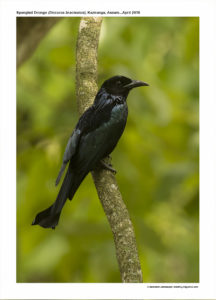Spangled Drongo

Spangled Drongo Dicrurus hottentottus
Etymology:
- Dicrurus : Greek word dikros – forked; ouros –tailed { Forked tailed} : dikros – forked; ouros –tailed { Forked tailed}
- Hottentottus : Nomad pastoral people of Namibia and South Africa.
Distribution in India: Resident of Western Ghats, Eastern Ghats and some parts of Tamilnadu, Andhra Pradesh. Also resident of Lower Himalayas and North Eastern states
Description: Size of 31- 32 cm. The nominate race has whole plumage blackish, glossed with metallic green on crown, wing-coverts and outer webs of upper tail-coverts, contrasting velvety mantle; gloss on crown, throat and upper breast limited to tips and marginal ends of feathers, forming sharply defined oval or pointed spangles (gloss lacking on lores, forehead and rest of underparts); glossy feathers on side of neck elongated, forming lanceolate hackles; remiges brownish-black; underwing-coverts with white tips and iridescent greenish-blue edges; tail long , moderately forked with characteristic upward-turned tips; hefty and slightly hooked bill, numerous thick rictal bristles partly covering nostrils; iris bright red; legs and feet black. Both the sexes are similar, male slightly larger than female. The juvenile is browner or dusky black and less glossy than adult, with undertail-coverts and belly feathers tipped white, giving spotted appearance, iris is brown.
Habitat: It is found in tropical wooded habitats: rainforest, monsoon and gallery forests, mangroves, teak plantations, tall secondary forest, forest edge, also villages and sometimes suburban gardens
Food Habits: It is omnivorous; eats mainly winged insects, but also caterpillars and teak moth pupae, and occasionally small vertebrates and fruits; diet also includes nectar, for this its tongue has brush-like tip. Vertebrates eaten include lizards, bats and small birds. Perches upright on horizontal branch and sallies out to capture insects in flight, mostly from middle levels of forest up to canopy, often catching prey flushed by other birds. It forages also among foliage and branches, occasionally pouncing on to ground or trunk; catches insects emerging from ground at dusk. It congregates and forages in burnt areas. It steals prey from other birds in air.
Breeding Habits: They breed in May-Aug. Pre-breeding display exhibited includes the two birds standing side by side, facing away from each other, calling, flicking tail and shaking wings, and facing each other and calling in unison while bobbing and bowing. The nest is built by both sexes in 4–9 days. The nest is a shallow cup of twigs, rootlets, stalks and tendrils of vine or fine grass, bound with spider web or other fine materials, lined with fine materials, firm but open enough for eggs to be seen from below. The nest is slung in fork of horizontal branch, same site may be used for several consecutive years. They may also nest in or near tree containing nest of other species, fort safety against predators. Parents attack any potential predator coming near nest. They lay a clutch of 2–5 eggs. Incubation done by both sexes for a period of19 days. Both parents feed chicks. The nestling period is 3 weeks. The fledglings accompany parents for up to 50 days. Nests parasitized by Common Koel and Pallid Cuckoo.